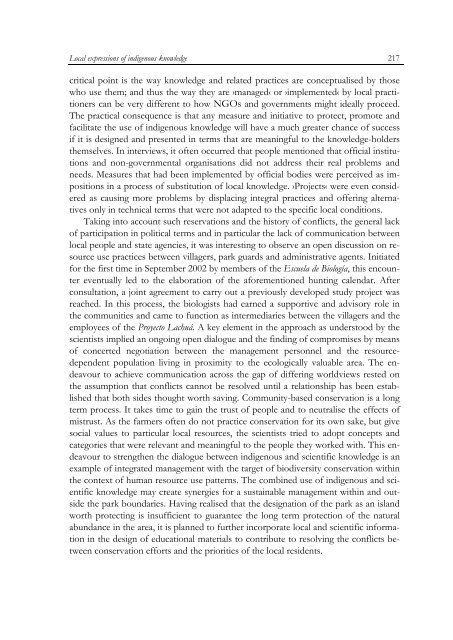The cultural context of biodiversity conservation - Oapen
The cultural context of biodiversity conservation - Oapen
The cultural context of biodiversity conservation - Oapen
Create successful ePaper yourself
Turn your PDF publications into a flip-book with our unique Google optimized e-Paper software.
Local expressions <strong>of</strong> indigenous knowledge<br />
critical point is the way knowledge and related practices are conceptualised by those<br />
who use them; and thus the way they are ›managed‹ or ›implemented‹ by local practitioners<br />
can be very different to how NGOs and governments might ideally proceed.<br />
<strong>The</strong> practical consequence is that any measure and initiative to protect, promote and<br />
facilitate the use <strong>of</strong> indigenous knowledge will have a much greater chance <strong>of</strong> success<br />
if it is designed and presented in terms that are meaningful to the knowledge-holders<br />
themselves. In interviews, it <strong>of</strong>ten occurred that people mentioned that <strong>of</strong>ficial institutions<br />
and non-governmental organisations did not address their real problems and<br />
needs. Measures that had been implemented by <strong>of</strong>ficial bodies were perceived as impositions<br />
in a process <strong>of</strong> substitution <strong>of</strong> local knowledge. ›Projects‹ were even considered<br />
as causing more problems by displacing integral practices and <strong>of</strong>fering alternatives<br />
only in technical terms that were not adapted to the specific local conditions.<br />
Taking into account such reservations and the history <strong>of</strong> conflicts, the general lack<br />
<strong>of</strong> participation in political terms and in particular the lack <strong>of</strong> communication between<br />
local people and state agencies, it was interesting to observe an open discussion on resource<br />
use practices between villagers, park guards and administrative agents. Initiated<br />
for the first time in September 2002 by members <strong>of</strong> the Escuela de Biología, this encounter<br />
eventually led to the elaboration <strong>of</strong> the aforementioned hunting calendar. After<br />
consultation, a joint agreement to carry out a previously developed study project was<br />
reached. In this process, the biologists had earned a supportive and advisory role in<br />
the communities and came to function as intermediaries between the villagers and the<br />
employees <strong>of</strong> the Proyecto Lachuá. A key element in the approach as understood by the<br />
scientists implied an ongoing open dialogue and the finding <strong>of</strong> compromises by means<br />
<strong>of</strong> concerted negotiation between the management personnel and the resourcedependent<br />
population living in proximity to the ecologically valuable area. <strong>The</strong> endeavour<br />
to achieve communication across the gap <strong>of</strong> differing worldviews rested on<br />
the assumption that conflicts cannot be resolved until a relationship has been established<br />
that both sides thought worth saving. Community-based <strong>conservation</strong> is a long<br />
term process. It takes time to gain the trust <strong>of</strong> people and to neutralise the effects <strong>of</strong><br />
mistrust. As the farmers <strong>of</strong>ten do not practice <strong>conservation</strong> for its own sake, but give<br />
social values to particular local resources, the scientists tried to adopt concepts and<br />
categories that were relevant and meaningful to the people they worked with. This endeavour<br />
to strengthen the dialogue between indigenous and scientific knowledge is an<br />
example <strong>of</strong> integrated management with the target <strong>of</strong> <strong>biodiversity</strong> <strong>conservation</strong> within<br />
the <strong>context</strong> <strong>of</strong> human resource use patterns. <strong>The</strong> combined use <strong>of</strong> indigenous and scientific<br />
knowledge may create synergies for a sustainable management within and outside<br />
the park boundaries. Having realised that the designation <strong>of</strong> the park as an island<br />
worth protecting is insufficient to guarantee the long term protection <strong>of</strong> the natural<br />
abundance in the area, it is planned to further incorporate local and scientific information<br />
in the design <strong>of</strong> educational materials to contribute to resolving the conflicts between<br />
<strong>conservation</strong> efforts and the priorities <strong>of</strong> the local residents.<br />
217

















